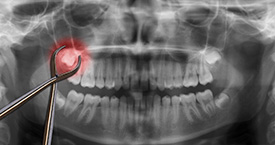Tooth Extractions
When something is difficult, we say it’s like pulling teeth. In reality, tooth extractions are routine dental treatments that help prevent more serious dental problems.
The most common tooth extractions are usually wisdom tooth extractions, but your dentist may also remove a tooth if it’s coming in at an angle, threatening the position of other healthy teeth or contributing to overcrowding in the mouth.

In some cases, a broken tooth may also need to be extracted, as well as teeth with significant tooth decay that cannot be treated by a root canal. Patients with advanced gum disease may be considered for tooth extractions as well.
While it’s your dentist’s goal to do everything to save your natural tooth, in the end, removing a potentially harmful tooth can spare you time, money and discomfort.
Preparing for Extractions: Tooth Extraction Cost
As with any recommended dental treatment, it’s important to discuss the cost of tooth extractions with your dentist.
Tooth extraction cost depends on the specifics of your case, but in general, the more difficult a tooth is to remove, the more it costs. For example, tooth extraction cost may be higher for an impacted wisdom tooth extraction than removing a loose and severely decayed tooth.
If you have dental insurance, find out if the tooth extraction cost is covered. If not, ask if the dentist office provides a payment plan to help make the tooth extraction cost manageable.
Make Appointment
Preparing for Extractions: Tooth Extraction Pain
Whether you’ll be having a wisdom tooth extraction or a tooth is being removed due to decay, feeling a little anxious about tooth extraction pain is understandable.
Although tooth extractions are one of the most straightforward oral surgery procedures, it’s still dental surgery.
One way to relieve your jitters is to learn what’s involved. Talk to your dentist about the process and your tooth extraction pain management options.
Most tooth extractions take just a few minutes. To reduce tooth extraction pain, you’ll receive local anesthesia to numb the tooth, jawbone and surrounding gums.
If you’re especially anxious about experiencing tooth extraction pain, sedation dentistry can be used to help you relax. Your dentist or oral surgeon will begin by rocking the tooth back and forth, and then rotating it to widen the socket for easier extraction.
Because your pain receptors have been numbed, you may sense a dull pressure, but you shouldn’t feel any tooth extraction pain. When the tooth is fully detached, your dentist will remove it and cover the exposed gum with a small piece of gauze.
